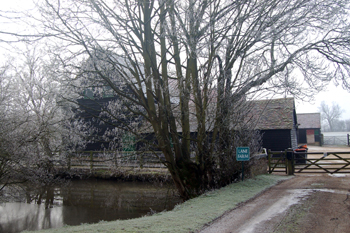
Lane Farm January 2010
Lane Farm stands some way out of the village, at the bottom of Chapel Lane. The Farmhouse was listed by the former Department of Environment in September 1980 as Grade II, of special interest. It notes that the left hand part and projecting gable are early 19th century and are built of red and blue brick with diaperwork to the projecting gable. The right hand section is late 19th century and built of yellow brick with red brick dressings. The house has two storeys beneath an old clay tile roof.
In 1829, following the death of the Earl of Bridgewater, his estate in Totternhoe was surveyed [BW1004]. The survey also included every building in the parish, whether owned by the estate or not (and at that date most were not). Lane Farm was owned by John Pedley and occupied by James Pratt and the farmhouse stood in one acre, two roods, thirty-eight poles. A similar survey was carried out in 1840 and by that date the farm was owned by Arthur Macnamara and occupied by Daniel Twidell junior.
The 1841 census reveals that farmer Daniel Twidell was aged about 45, and lived with his wife Elizabeth, who was of a similar age, and their children Bessy, aged about 20; William, Jane and Fanny aged about 15, Mary aged 13; Sarah, aged 11; Daniel, aged 9; Ann, 6 and John, 4. two male servants - James Pitkin aged about 20 and John Liney, aged 12, also lived with them.
The 1840 reference book is annotated "Earl Brownlow, J. Gurney" as Arthur Macnamara sold his Totternhoe estates to the Earl at a later date. Earl Brownlow put the Totternhoe Estate up for sale in 1916 [Z513/22]. Lot 17 was Lane Farm, described as "A Valuable and Compact Holding including productive Orchards and FruitLands". The farm comprised 63 acres, 3 roods, 22 poles and was let to the executors of F. Henley at £148/5/- per annum.
The farmhouse was described as occupying: "a convenient position adjoining the Village of Totternhoe, well away from the main road, about one mile from Stanbridgeford Railway Station. It is brick built and tiled, and has the following accommodation: - Four Bedrooms on the Upper Floor, and Parlour, Sitting Room, tile-paved Kitchen and Scullery, with pump and sink, tile-paved Dairy and Larder on the Ground Floor".
"The Extensive and well-constructed FARM BUILDINGS are placed at the rear and side, are principally timber built on brick foundations, and include Barn, 6-bay open Cattle Shed and Yard, Loose Box, Cow Shed for six, Piggery, and Hen House, 4-bay open Cart Shed and Loft, Two Pigsties, 4-bay open Cattle Shed, three-division Piggery, Cart-horse Stable for four, and Loose Box, Coach and Fowl House. At a convenient distance is a brick-built and slated detached COTTAGE, having Four Rooms and Garden. Water from well. Also a brick, weather-boarded, slated, two-division Barn". F. Henley had also leased 20 acres, 3 roods, 9 poles of "exceptionally productive arable land" for £31/10 per annum. This was Lot 17a.
The Rating and Valuation Act 1925 specified that every piece of land and property in the country should be valued to determine its rateable value. Totternhoe, like much of Bedfordshire, was assessed in 1927 and the valuer visiting Lane Farm [DV1/H25/40] noted that it was owned and occupied by Miss Annie Henley and sons (a case of the former tenant buying the freehold in 1916). The farm contained about 82 acres - clearly Lots 17 and 17a of 1916. The valuer's, rather curious notes, read: "Down a Long Lane. Saw Her & him. Tree planted!" He also noted that water came fro ma well and that the Henleys had a telephone. Another hand has commented: "Nice House and Homestead. Thatched Barn".
The brick and tile farmhouse comprised two reception rooms, a kitchen, scullery, pantry and dairy with three bedrooms ("1 sloping") and a boxroom upstairs. Outside stood a brick, timber and slate scullery and a brick and tiled two-seater earth closet. The homestead comprised three brick and tiled loose boxes; a timber and corrugated iron four bay open hovel; a large timber, tiled and thatched barn; a brick, timber and tiled mixing house and three calf pens; a timber and corrugated iron six bay open feeding hovel; a timber and corrugated iron cow house for twelve and calf pen; a timber and corrugated iron open cart shelter; a brick and slate stable for six, a chaff place and loose box, coalhouse used as a garage and a hen house.
The Bedfordshire Historic Environment Record [HER 14025] notes that the stream running near Lane End Farmhouse was the probably site of the four ancient mills mentioned in
Domesday Book.